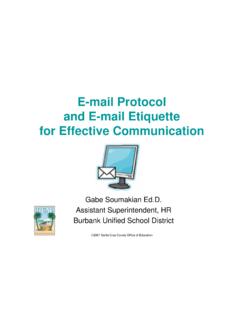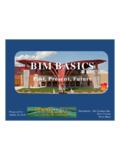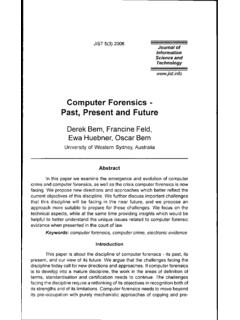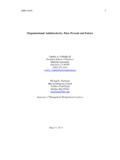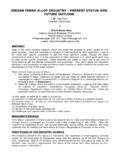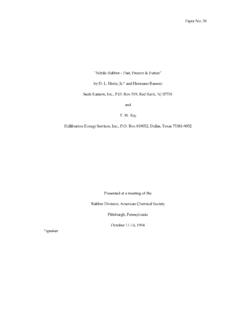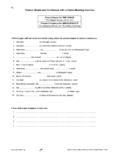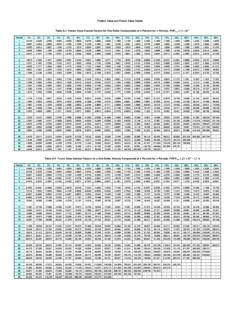Transcription of Research on Computers and Education: Past, Present …
1 Research on Computers and Education: Past, Present and FuturePrepared for the Bill and Melinda Gates FoundationJeffrey T. FoutsProfessor of EducationSeattle Pacific UniversitySeattle, WAFebruary, 2000iExecutive SummaryComputers and related technologies are now in almost every school across thenation. State reform efforts include the integration of technology in curriculum standardsand sometimes make technology skills a separate standard for students to achieve. As thefocus on technology expands, policy makers and tax payers are asking researchers ineducational practice to provide the data for thoughtful decision making on the use oftechnology for learning. At this time the decision-making is often hampered by the lackof adequate Research , although there is considerable work from previous years to guidefuture evolution of technology useThe computer was introduced into education in the 1970s and its first usehad teachers and students learning to program.
2 Since that time there has been anevolution of best practices. As software gained in sophistication, the computer becamethe tutor or surrogate teacher. Students followed the commands on the computer screenreceiving rewards for correct answers. They also began to learn through playing gamesand simple simulations. Teachers of writing discovered the value of using a wordprocessor and soon students were writing more and revising with ease. Other teacherssaw the value of the computer in creating a rich learning environment and had studentsusing databases, spreadsheets, presentation and Research tools across all subject the Internet impacted technology use. Suddenly there was a volume of knowledgeavailable to students with access and a network of people throughout the world thatenhanced communication and the exchange of ideas.
3 Real problem solving incollaborative groups became the norm in some classrooms. Online courses were availableand students in rural areas had expanded learning opportunities in a variety of subjectareas. Previously abstract concepts could now be illustrated and manipulated because oftechnology advancements. A whole new learning environment became it make a difference? It in traditional classrooms has shown that technology can have a positiveimpact on student achievement if certain factors are Present , including extensive teachertraining and a clear purpose. In recent years researchers have found that the technologycan be an important component for creating exciting new learning environments forstudents, once again dependent on other factors such as: Lower student to computer ratio; Teacher ownership of the reform efforts; Extensive teacher training and planning time; High levels of technological , these factors are often missing in school technology implementationefforts, resulting in inconclusive Research findings of the effects of these environments onstudent learning.
4 Sometimes schools make large purchases of technology for classroomsbut ignore the accompanying teacher training. At other times resources are wasted asteachers receive training only to return to a classroom with limited or no access for thestudents. This leads many observers to question the benefits of technology in the Research challenge is to construct viable studies where all the necessary factors are critical questions for the futureAs educators and researchers look to the future they are no longer asking thequestion, Should technology be used in education? Instead the focus is How shouldtechnology be used to help students achieve higher levels? Across the country there arefine examples of technology use in scattered classrooms and a few schools, but thechallenge is to bring a technology rich learning environment to every student.
5 In the eraof new standards and high performance schools, technology must be linked not only tostudent learning but also the efficient management of schools and districts. Littleresearch is available in this area. The potential of learning anywhere, any time is justbeginning to be tapped. Online courses and virtual schools, learning communities,apprenticeships and internships will change the concept of school in this Research is needed to answer several critical questions as technology isthoughtfully deployed throughout our schools. Ten critical questions for further studyare: How can technology increase student learning and assist students in meeting thestandards? Do students learn and retain more with the aid of Computers ? How does the use of Computers affect classroom climate and student attitudes?
6 What are the conditions that must be in place for technology to effectively improvestudent learning and especially the achievement of at-risk students? How can technology serve as an extension of human capabilities and cognitivefunctioning? What specific cognitive skills are enhanced by the use of technology for learning? How can online assessment be used to enhance student learning and accountability? What are the effective deployments for a technology rich learning environment? What constitutes effective and adequate teacher training? How can technology improve productivity in all aspects of district, school, andclassroom management?As researchers begin or continue their important work, their conclusions will provide aguide for educators and others to make good decisions about how to use technology forlearning both inside and outside our Bill and Melinda Gates Foundation planThis current Research and the questions for the future are consistent with the GatesEducation Initiative that seeks to Help All Students Achieve.
7 The foundation will workwith leaders in fifty states to assure that principals and superintendents have theknowledge to create rich technology learning environments where all students canachieve at high levels. Our teacher project will create model classrooms and show thepossibilities as we encourage and participate in the action to provide every student aquality teacher. Our work will also involve comprehensive support for schools anddistricts to create quality places where others can visit and learn the elements necessaryfor success. These will be scalable models that are possible for all schools to we will conduct evaluation and action Research to answer the critical questionsand also to adjust our programs as we learn together with educators and theircommunities across the of ContentsPageExecutive Summaryi-iiiIntroduction1 Past and Present Research Findings on Computers and RelatedTechnology in Education The Computer as Tutor and Surrogate Teacher Technology as a Transformational Agent and Learning Tool Large Scale Studies with Policy Implications Computers , New Learning Environments, and Technological Literacy Computers , Technology and Distance Learning Technology as an Educational Management/Efficiency Tool Conclusions5591822232527 Research Serving the Profession.
8 A Research Agenda forTechnology and the Schools Critical Issues in Educational Technology Research Basic Assumptions for a Research Agenda The Computer as Tutor and Surrogate Teacher Technology as Transformational Agent, Learning Tool, and Student Learning Computers , New Learning Environments, and Technological Literacy Computers , Technology and Distance Learning Technology as an Educational Management/Efficiency Tool3131333435404041 References42 Research on Computers and Education: Past, Present and FutureJeffrey T. FoutsIntroductionAs the new millennium begins schools throughout the country are in the midst ofreform efforts the term restructuring often being used to imply a deeper, morefundamental change in the nature of schools and schooling than that implied by reform. These efforts often involve a rethinking of the very nature of schools and the educationalexperience for children.
9 Resulting changes may be structural in nature, such as a revisionof the school day or the school year, or they may be more fundamental in nature,resulting in a very new curriculum that asks students to learn and perform in ways muchdifferent than driving force of these restructuring efforts is the belief that a school systembuilt on a Nineteenth Century industrial efficiency model is inadequate to meet the needsof the society of the Twentieth-First Century that has been transformed by technology has transformed businesses and many other components of daily life,many are relying on technology to help transform the nature of the school experience. Asthe new millennium begins that transformation is still October 1999, at the National Education Summit states were asked to fullyimplement the final stage of their reform efforts by adopting policies that held schoolsand educators accountable for their successes and for their failures.
10 Results matter, andtherefore determining what best produces desirable results is an important part of theaccountability is evidence that Computers and the related technologies1 have made majorinroads into the schools. There are now an estimated 10 million Computers in the schoolswith annual school expenditures for technology of about 6 billion dollars. There is oneinstructional computer for every students and more than half of the nation sclassrooms have been connected to the Internet. A 1999 national survey conducted byEducation Week in collaboration with the Milken Exchange found that 97% of allteachers surveyed use a computer for educational purposes, either at home or at school,and 53% use software for classroom instruction. Virtually every state reform planincludes technology as an integral component, and student school access to technology ishigher than ever before.
